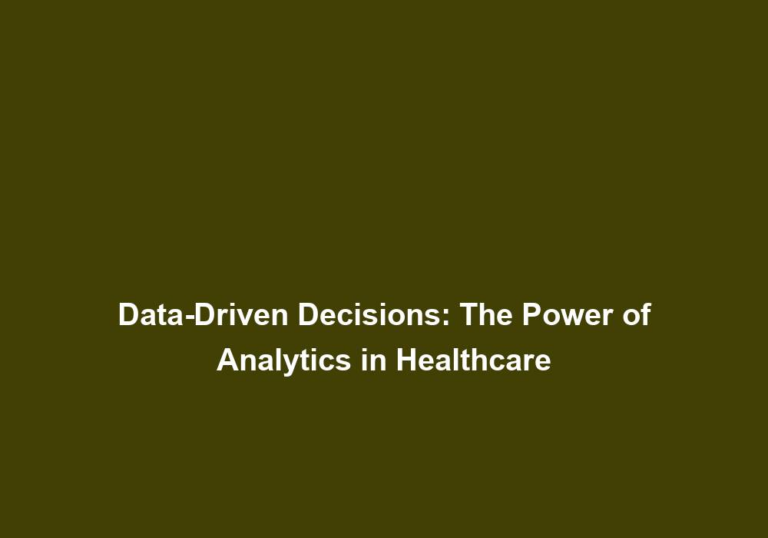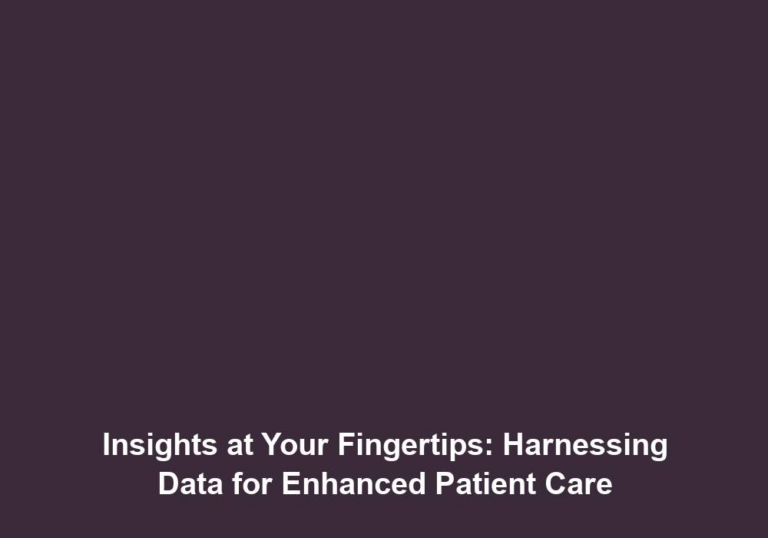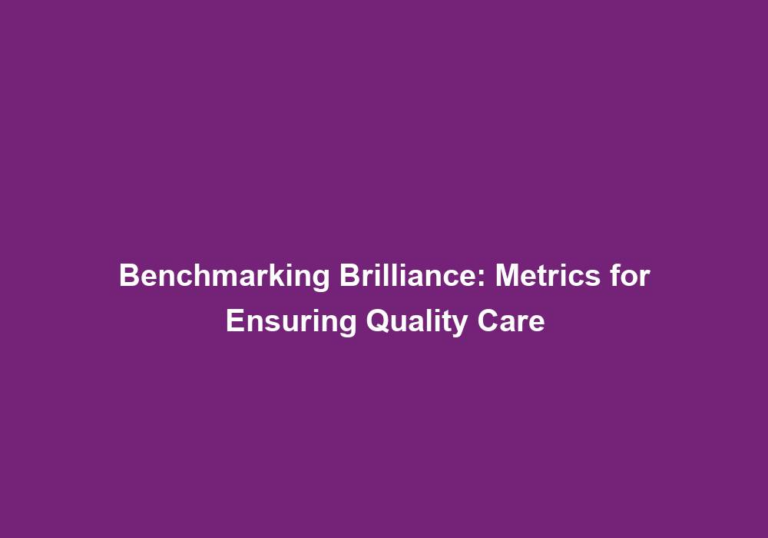Ahead of the Curve: Using Predictive Analytics to Shape Patient Care
In today’s rapidly evolving healthcare landscape, staying ahead of the curve is crucial for healthcare providers. One way to achieve this is by leveraging the power of predictive analytics. By harnessing the vast amount of available healthcare data, predictive analytics enables healthcare professionals to make more informed decisions, improve patient care, and ultimately save lives. In this article, we will explore the various ways predictive analytics can be utilized to shape patient care and enhance healthcare outcomes.
Understanding Predictive Analytics in Healthcare
Predictive analytics involves the use of statistical algorithms and machine learning techniques to analyze historical data and predict future events or outcomes. In the context of healthcare, predictive analytics involves analyzing vast amounts of patient data to identify patterns, trends, and potential risks. By doing so, healthcare providers can proactively intervene and prevent adverse events, optimize treatment plans, and personalize patient care.
Predictive analytics in healthcare has the potential to revolutionize the way we approach patient care. By analyzing and interpreting patient data, healthcare professionals can gain valuable insights into patient health and make more informed decisions. This allows for early detection and prevention of diseases, as well as the optimization of treatment plans.
Predictive analytics algorithms can identify individuals who are at a higher risk of developing certain medical conditions by analyzing various factors such as medical histories, lifestyle choices, and genetic information. This early detection enables healthcare providers to intervene promptly, implement preventive measures, and potentially avoid the onset of chronic diseases or complications.
By incorporating targeted interventions such as lifestyle modifications, regular check-ups, and personalized treatment plans, healthcare professionals can effectively reduce the likelihood of disease progression and improve patient outcomes. This proactive approach to healthcare not only benefits individual patients but also contributes to the overall improvement of public health.
Enhancing Early Detection and Prevention
One of the key applications of predictive analytics in healthcare is early detection and prevention. By analyzing patient data, including medical histories, lifestyle factors, and genetic information, predictive analytics algorithms can identify individuals who are at a higher risk of developing certain medical conditions. This enables healthcare providers to intervene early, implement preventive measures, and potentially avoid the onset of chronic diseases or complications.
For example, by leveraging predictive analytics, healthcare providers can identify patients who are at a higher risk of developing diabetes. By implementing targeted interventions such as lifestyle modifications, regular check-ups, and personalized treatment plans, healthcare professionals can reduce the likelihood of the disease progressing and improve patient outcomes.
In addition to early detection, predictive analytics can also help healthcare providers identify potential risks and complications before they occur. By analyzing historical patient data, predictive analytics algorithms can identify patterns and trends that may indicate an increased risk of adverse events. This allows healthcare providers to proactively intervene, implement preventive measures, and ultimately save lives.
Predictive analytics can also play a crucial role in identifying patients who are at a higher risk of readmissions or hospital-acquired infections. By analyzing patient data, including medical histories and treatment outcomes, healthcare providers can identify factors that contribute to these risks. This enables healthcare professionals to develop targeted strategies to reduce readmissions and prevent infections, improving patient outcomes and reducing healthcare costs.
Optimizing Treatment Plans and Resource Allocation
Predictive analytics can also play a crucial role in optimizing treatment plans and resource allocation within healthcare systems. By analyzing patient data, including demographics, medical history, and treatment outcomes, predictive analytics algorithms can generate insights into the most effective treatment options for different patient profiles.
For instance, by analyzing data from patients with similar characteristics and treatment histories, healthcare providers can predict the effectiveness of different treatment options for a specific patient. This enables them to make more informed decisions, select the most appropriate treatment plan, and increase the chances of successful outcomes.
Furthermore, predictive analytics can help healthcare systems optimize resource allocation. By analyzing data on patient demand, resource availability, and treatment outcomes, healthcare providers can identify areas where additional resources are needed and allocate them accordingly. This ensures that resources are utilized efficiently, reducing wait times, improving access to care, and enhancing patient satisfaction.
By optimizing treatment plans and resource allocation, healthcare providers can improve patient outcomes and reduce healthcare costs. By identifying the most effective treatment options for different patient profiles, healthcare providers can ensure that patients receive the best possible care. Additionally, by allocating resources efficiently, healthcare systems can reduce wait times and improve access to care, leading to better patient satisfaction.
Personalizing Patient Care
Every patient is unique, and their healthcare needs may vary significantly. Predictive analytics empowers healthcare providers to personalize patient care by tailoring treatment plans based on individual characteristics and predicted outcomes. By analyzing patient data, including demographics, medical history, genetic information, and lifestyle factors, predictive analytics algorithms can generate personalized recommendations for treatment, medication dosage, and lifestyle modifications.
Personalized patient care leads to better treatment outcomes and patient satisfaction. By taking into account individual characteristics and predicted outcomes, healthcare providers can develop treatment plans that are tailored to the specific needs of each patient. This personalized approach not only improves patient outcomes but also enhances patient engagement and satisfaction with the healthcare experience.
For example, imagine a patient with cardiovascular disease who has a specific genetic variant that affects their response to certain medications. By leveraging predictive analytics, healthcare providers can identify this genetic variant and adjust the treatment plan accordingly, ensuring that the patient receives the most effective medication at the optimal dosage.
Personalized patient care also extends beyond treatment plans. Predictive analytics can help healthcare providers identify patients who may benefit from additional support services, such as mental health counseling or lifestyle coaching. By identifying these needs early on, healthcare providers can connect patients with the appropriate resources and improve overall patient well-being.
Improving Patient Outcomes and Safety
Ultimately, the goal of leveraging predictive analytics in healthcare is to improve patient outcomes and safety. By identifying high-risk patients, optimizing treatment plans, and personalizing care, healthcare providers can reduce adverse events, prevent complications, and enhance overall patient well-being.
Additionally, predictive analytics can be used to enhance patient safety by identifying potential medication errors or adverse drug reactions. By analyzing patient data, including medication history, medical records, and genetic information, healthcare providers can identify patients who are at a higher risk of experiencing adverse reactions to specific medications. This enables healthcare professionals to adjust medication dosages or select alternative treatments, minimizing the risk of harm to the patient.
By leveraging predictive analytics, healthcare providers can continuously improve patient care and safety. By analyzing patient data and identifying potential risks or adverse events, healthcare professionals can intervene proactively and prevent harm. This not only improves patient outcomes but also contributes to the overall improvement of healthcare quality and patient safety.
Conclusion
Predictive analytics has the potential to revolutionize patient care by enabling healthcare providers to be ahead of the curve in making informed decisions. By leveraging the power of data analysis and machine learning techniques, predictive analytics empowers healthcare professionals to enhance early detection and prevention, optimize treatment plans, personalize patient care, and improve patient outcomes and safety. As the healthcare industry continues to embrace technological advancements, predictive analytics will undoubtedly play a crucial role in shaping the future of patient care.






